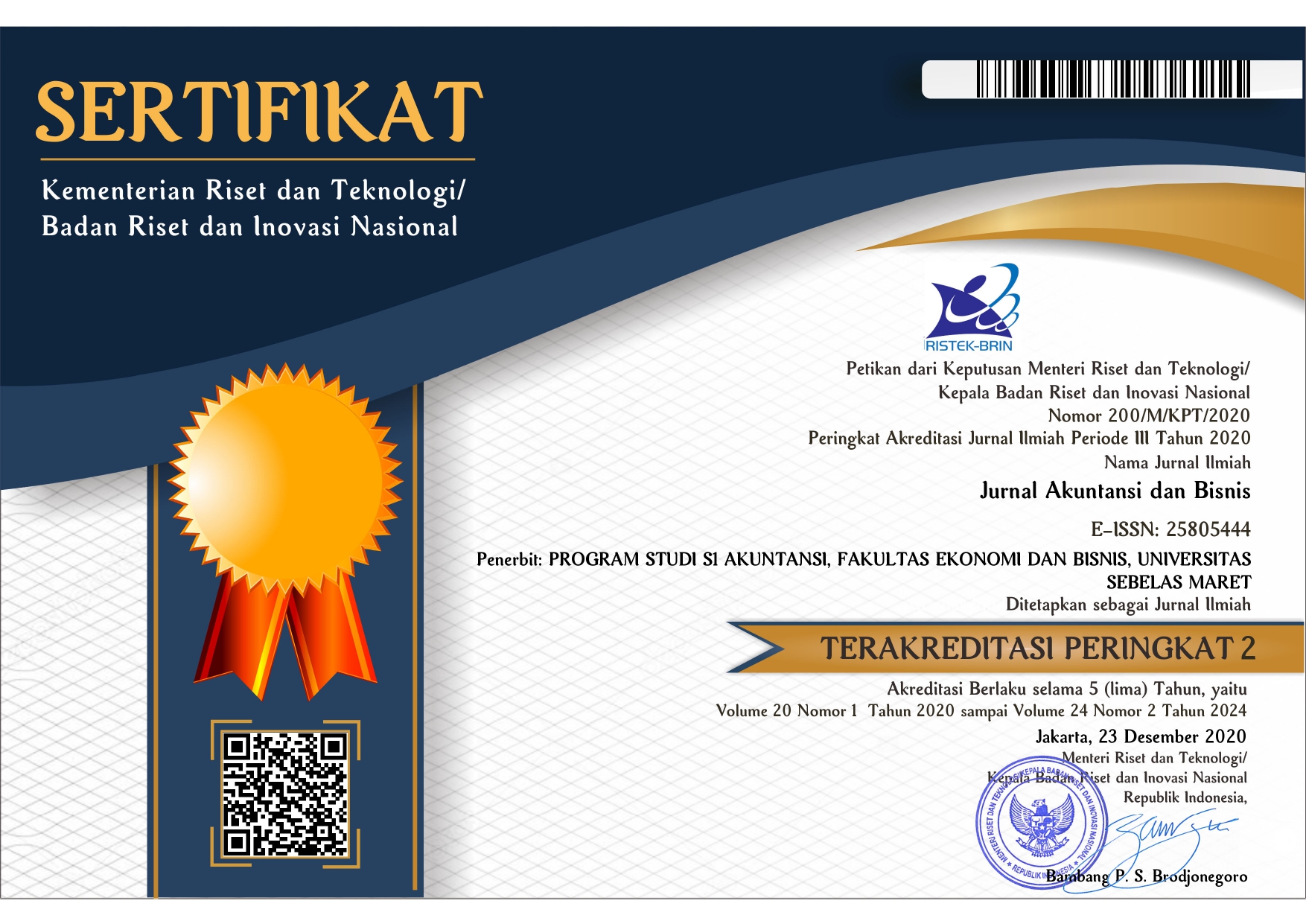Relevansi Kandungan Informasi Komponen Arus Kas dan Laba dalam Memprediksi Arus Kas Masa Depan
Abstract
References
Ali, A., 1994, “The Incremental Information Content of Earnings, Working Capital from Operations, and Cash Flows”, Journal of Accounting Research, 32 (1), pp. 61-74.
Bernard, L. Victor dan Jacob K. Thomas. 1990. “Evidence that Stock Prices do not Fully Reflect the Implications of Current Earnings for Future Earnings”. Journal of Accounting and Economics, 13. pp. 305-340.
Black. L. Ervin. 1998. “Which is More Value Relevant: Earnings or Cash Flows? A Life Cycle Examination”. Working paper from University of Arkansas.
Foster, George. 1986. Financial Statement Analysis. New Jersey: Prentice-Hall.
Fairfield, M. Patricia dan Teri Lombardi Yohn. 2000. “Are Cash Earnings Better than Accrued Earnings?”. Working paper.
FASB. 1978. “Statement of Financial Accounting Concept no.1: Objectives of Financial Reporting by Business Enterprises”, FASB: Stamford.
_____, 1987.”Statement No.96: Statements of Cash Flow”, FASB: Stamford.
Freeman, N. Robert dan S.Y. Tse. 1992. “A Non Linierity Model of Security Price Responses to Unexpected Earnings”. Journal of Accounting Research 30 (2).pp. 185-209.
Gonedes, J.N., 1978, “Corporate Signaling, External Accounting, and Capital Market Equilibrium: Evidance on Dividends, Income, and Extraordinary Items”, Journal of Accounting Research 16, pp.27-77.
Ikatan Akuntan Indonesia, 1994,”Pernyataan Standar Akuntansi Keuangan: Kerangka Dasar Penyusunan dan Penyajian Laporan Keuangan”, Jakarta: Salemba Empat.
_____________________, 1994,”Pernyataan Standar Akuntansi Keuangan No.2: Laporan Arus Kas”, Jakarta: Salemba Empat
Livnat Joshua dan paul Zarowin. 1990. “The Incremental Information Content of Cash Flow Components”. Journal of Accounting and Economics, 13. pp. 25-46.
Lorek, K.S. dan G.L. Willinger, 1996. “Multivariate Time Series Prediction model for Cash Flow Data”, The Accounting Review 71. pp. 81-102.
------------, Thomas F. Schaefer dan G. Lee Willinger. 1993. Time Series Properties and Predictive Ability of Funds Flow Variables. The Accounting Review 68. pp. 151-163.
Raybun, Judy, 1986, The Association of Operation of Operating Cash Flows and Accruals with Security Return, Journal of Accounting Research 24, p. 112-138.
Stephens G. Ray dan Vijay Govindarajan. 1990. On Assessing a Firm’s Cash Generating Ability. The accounting review vol. 65. hal. 253-268.
Supriyadi, 1998, “The Association Between Accounting Information and Future Cash Flows: An Indonesian Case Study”, Dissertation, Lexington, Kentucky.
Sutopo, Bambang. 2001. Dampak Pemoderasi Perataan Laba terhadap Kandungan Informasi Inkremental Arus Kas. Disertasi S3. UGM, Yogyakarta.
______________. 2002. Earnings-Price Ratio dan Kandungan Informasi Arus Kas.. Perspektif vol.7 no.2. hal.105-112.
Wilson, G. Peter. 1986. The Relative Information Content of Accruals and Cash Flows: Combined Evidence at the Earnings Announcement and Annual Report Release Date. Journal of Accounting Research vol.24 Supplement.pp. 165-200.
DOI: http://dx.doi.org/10.20961/jab.v5i1.18
Jurnal Akuntansi dan Bisnis (JAB)
ISSN 1412-0852 (print), 2580-5444 (online)
Published by Accounting Study Program, Faculty of Economics and Business, Universitas Sebelas Maret, Indonesia

JAB on http://jab.fe.uns.ac.id/index.php/jab is licensed under a Creative Commons Attribution-ShareAlike 4.0 International License










